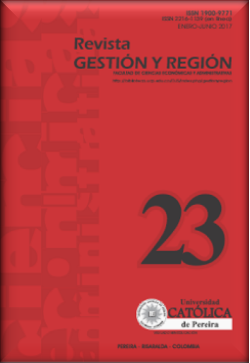Generación y: Estrategias de retención de talento en el sector financiero en la ciudad de Medellín
Palabras clave:
Generación Y, Millennials, estrategia, retenciónResumen
Con la llegada de la llamada generación Y o millennials las empresas enfrentannuevos desafíos, a saber, la rotación constante de su personal, el deterioro en elsentido de pertenencia y permanencia, las dificultades para llevar a feliz puertoproyectos de largo plazo y la fuga de sus talentos, máxime cuando en pocosaños esta generación constituirá la mayor fuerza laboral del mercado. Esteinforme presenta las estrategias deliberadas de retención de talento en los sieteprincipales bancos del Valle de Aburrá, Colombia.
Referencias
Bass, J. (2012). Nurse Leader. Chief Millennial Officer: It’sTime to Write the Job Description, 10(5), 48-49. doi: S1541461212000523.
Bergman, M., Fearrington, S., Matthew, E., Davenport, E. Shaun, W. & J. Bergman (2011). Personality and Individual Differences. Millennials, narcissism, and social networking: What narcissists do on social networking sites and why. 50(5), 706-711. doi: S0191886910006215.
Bilgihan, A. (2016). Computers in Human Behavior. Gen Y customer loyalty in online shopping: An integrated model of trust, user experience and branding, 61, 103-113. doi:S0747563216301753.
Brown, A., Thomas, E., Nicholas, J. & Bosselman, R. (2015). International Journal of Hospitality Management. Are they leaving or staying: A qualitative analysis of turnover issues for Generation Y hospitality employees with a hospitality education, 46, 130-137. doi: S0278431915000183.
Cat, F. y Maillot, F. (2012). IEEM Revista de Negocios. Prácticas de RSE y retención: ¿Qué están haciendo las empresas?, 82-83. Recuperado de http://ezproxy.eafit.edu.co:2121/ehost/detail/detail?sid=81ab5426-6464-490f-89ec50603232cc84%40sessionmgr4006&vid=0&hid=4204&bdata=Jmxhbmc9ZXMmc2l0ZT1laG9zdC1saXZl#AN=96229882&db=fua
Çelikdemir, Z. & Deniz, I. (2015). 11th International Strategic Management Conference 2015. Incorporating Ethics into Strategic Management with regards to Generation Y’s view of Ethics, 207. 528-535. doi: S1877042815052568.
DeMaria, A. (2013). Journal of the American College of Cardiology. Here Comes The Millennials, 61(15), 1654- 1656. doi: S0735109713010802.
Durocher, S., Bujaki, M. & Brouard, F. (2016). Critical Perspectives on Accounting. Attracting Millennials: Legitimacy management and bottom-up socialization processes within accounting firms, 39, 1-24. doi: S1045235416300065.
Irizari-Hernández, E. (2009). Revista Empresarial Inter Metro. La Generación Yo Generación Milenaria: El Nuevo Paradigma Laboral, 5(2), 10-25. Recuperado de http://ceajournal.metro.inter.edu/fall09/irizarryhernandez0502.pdf
Jabary, I. (2015). Capital Humano. Cómo gestionar y formar a la generación de los Millennials, 28(298). 106-109. Recuperado de http://ezproxy.eafit.edu.co:2192/ehost/detail/detail?vid=1&sid=0d45f8a9-1ea3-4dd4-8ed5-a9c77911dc92%40sessionmgr105&hid=123&bdata=Jmxhbmc9ZXMmc2l0ZT1laG9zdC1saXZl#AN=112828894&db=fua
Lim, H. (2012). Social and Behavioral Sciences. Attracting and retaining Generation Y engineering and business professionals in the Middle-east, 62, 25-29. doi: S1877042812034477.
Luscombe, J., Lewis, I . & Biggs, H. (2012). Emerald Insight. Essential elements for recruitment and retention: Generation Y, 55(3), 272-290. Recuperado de http://ezproxy.eafit.edu.co:2192/ehost/detail/detail?vid=7&sid=c2e2b200-3589-40ea-8d14-759aafc22253%40sessionmgr107&hid=123&bdata=Jmxhbmc9ZXMmc2l0ZT1laG9zdC1saXZl#AN=88053423&db=a9h
Marín, I. (2016). Debates IESA. El Buen Gestor Del Talento Humano: Retos Y Necesidades De Capacitación, 21(1), 38-41. Recuperado de http://virtual.iesa.edu.ve/servicios/wordpress/wp-content/uploads/2016/04/2016-1-garciamarin.pdf
Maxwell, A. & Broadbridge, A. (2014). European Management Journal. Generation Y graduates and career transition: Perspectives by gender, 32(4), 547-553. doi: S0263237313001588.
Portocarrero, F. (2013). Capital Humano. La retención del talento emprendedor, un asunto de Estado, 26(276), 36-38. Recuperado de http://ezproxy.eafit.edu.co:2121/ehost/detail/detail?sid=0faf2e69-0fd3-4622-8f2a-342ec730e442%40sessionmgr4009&vid=0&hid=4204&bdata=Jmxhbmc9ZXMmc2l0ZT1laG9zdC1saXZl#AN=87558776&db=fua
Rodríguez, C. (2014). Capital Humano. Objeto y evolución de la atracción y retención del talento, 27(289), 60-64. Recuperado de http://ezproxy.eafit.edu.co:2121/ehost/detail/detail?sid=4c07b723-77e7-4df4-9247-c0208cf8262e%40sessionmgr4006&vid=0&hid=4204&bdata=Jmxhbmc9ZXMmc2l0ZT1laG9zdC1saXZl#AN=98226646&db=fua
Sox, B., Kline, F., Sheryl, F. & Crews, B. (2014). International Journal of Hospitality Management. Identifying best practices, opportunities and barriers in meeting planning for Generation Y,. 36,. 244-254. doi:S0278431913001291.
Sherman, R., Saifman, H., Schwartz, R. & Schwartz, C. (2015). Nursing Plus Open. Factors that lead Generation Y nurses to consider or reject nurse leader roles, 1, 5-10. doi: S2352900815000035.
Smith, S. & Galbraith, Q. (2012). Journal of Academic Librarianship. Motivating Millennials: Improving Practices in Recruiting, Retaining, and Motivating Younger Library Staff, 38(3), 135-144. Recuperado de http://ezproxy.eafit.edu.co:2192/ehost/detail/detail?vid=17&sid=c2e2b200-3589-40ea-8d14-759aafc22253%40sessionmgr107&hid=123&bdata=Jmxhbmc9ZXMmc2l0ZT1laG9zdC1saXZl#AN=89720756&db=a9h
Werther, W. y Davis, K. (2014). Administración de recursos humanos: Gestión del capital humano. México D.F. Mc Graw Hill.
Wieck, K. (2008). Nurse Leader. Managing the Millennials. 6(6), 26-29. doi:S1541461208002073.

